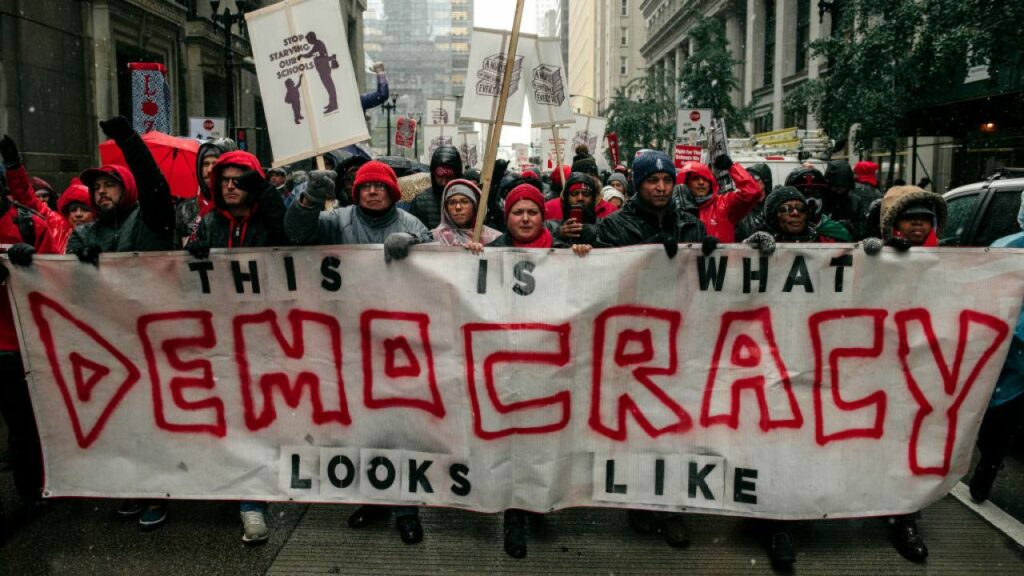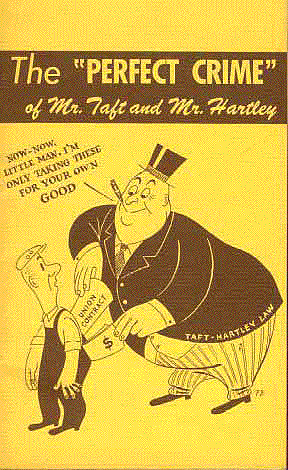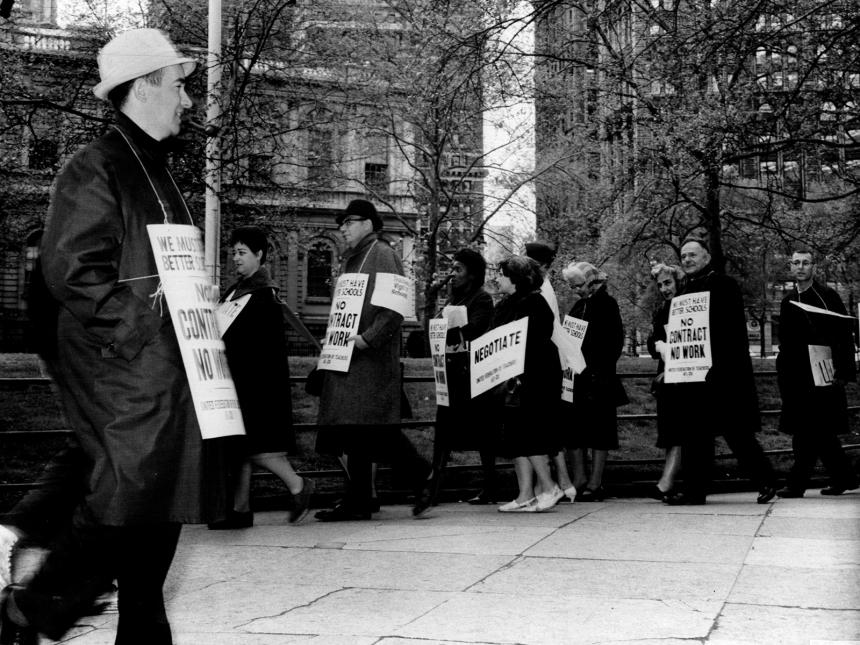Understanding unions in the United States
A primer on labor law and history

Gallup has reported that two-thirds of people in the United States approve of labor unions, the highest rating in two decades. And yet, unions represent the smallest share of the workforce in one hundred years—fewer than before there was a legal right to form a union and collectively bargain with an employer. Only one in ten workers in the U.S. are represented by a union, in the private sector it is even fewer: roughly one in twenty (6.2 percent).

With so few union members, even workers who are favorable to unions have little direct experience with the labor movement or the maze of labor relations in this country. What follows is an explanation of the context in which unions operate and why things shaped up the way they did. It is especially important for workers who want to organize and be a part of reviving the labor movement to know how things work and to understand what needs to be different.
Back in the day
A union is a group of workers acting together for better wages and working conditions. But unions also exist in a complicated legal framework with a history. In the U.S., workers did not have the legal right to form unions at their workplaces until the 1930s, when the National Labor Relations Act (NLRA) was passed in 1935. (Technically, the right to organize was first recognized when the National Industrial Recovery Act was passed in 1933, but this collapsed and gave way to the NLRA in 1935.) Before then, unions had little legal standing and were often regarded as a criminal conspiracy. Employers had no obligation to recognize or negotiate with unions, and they routinely suppressed unions by firing or blacklisting organizers, creating spy networks, and hiring goon squads like the Pinkerton detective agency to attack unionists.
To get anything from an employer, unions had to disrupt production and stop business as usual. First, to bargain for a contract, an employer had to be willing to recognize the union—essentially agree to deal with the workers’ organization and be willing to acknowledge it as a representative of their workers. Most employers resisted recognizing unions as long as they could, and it would take numerous battles, boycotts, work disruption, strike action, and secondary strikes to force an employer to agree to deal with the union.
If workers were able to push the employer to recognize their union and negotiate, enforcement of an agreement required job action to protect the integrity of that agreement. Companies sometimes created their own unions that they controlled (“yellow unions”) to undermine independent unions, which workers had to confront to protect their organization and the things that they had won. This was the world unions lived in before the NLRA—and somehow a larger share of workers were union members back then.
The National Labor Relations Act
The legal right to organize followed intense conflict between workers and employers. In 1934, bitter union fights boiled over into general strikes in Minneapolis, Toledo, and San Francisco. The NLRA created legal mechanisms for organized labor with the intention of mediating fights through labor boards set up by the government that would bind both unions and companies. The NLRA introduced the features of the labor movement today:
- Legal recognition of the right of workers to join a union, to act collectively, and to strike
- A legal process for recognition of a union, binding both sides
- Exclusive representation by one union, if certified as the representative of workers in a “bargaining unit”
- A defined set of rules that employers would have to observe in the process of working towards union certification (“unfair labor practices”)
- A requirement that both sides must bargain in good faith after a union is certified
- Establishment of a labor board to rule on disputes, the National Labor Relations Board (NLRB)
That is a lot, so let’s unpack it. First, the NLRA does not cover all workers, and only governs the private sector. The NLRA excludes domestic workers, farm workers, and “independent contractors,” which reflects racist and sexist attitudes, since these industries were (and are) racialized and gendered. (Rail and airline workers are governed separately by the “Railway Labor Act.”)
Second, the recognition process in the act is now what we commonly refer to as “unionization,” but that is not technically correct. Any group of workers acting together can be a union. What the NLRA does is provide a path for a union to be recognized by the employer as “exclusive bargaining agent”—a union that speaks on behalf of all workers in a defined area. Exclusive representation is a feature of labor law in the U.S., and it comes out of the struggle against company unions. Before the NLRA, companies would try to deter workers from joining independent unions by creating their own rival, company-controlled unions to divide workers and weaken organizing efforts—exclusive representation curbs that. When a union is certified, no other union may represent workers in that bargaining unit (a defined group of employees represented by that union), and no deals can be made with individual workers.
The NLRA outlines three ways to establish union recognition: recognition strikes, voluntary recognition, and NLRB secret elections. Certification of union recognition is necessary to be able to bargain a union contract.
Strike recognition basically does not happen anymore, but it is included as a legal way to be certified because it used to be the way unions won recognition. Workers would declare their union, and strike to stop work until the employer agreed that the union is the legitimate organization of the workers. In the NLRA, this process ends with the employer agreeing that the result of the strike is certification of the union.
Voluntary recognition is rare, but an employer can simply agree to deal with the union. In modern union campaigns, unions often request voluntary recognition before they file for an election with the NLRB—they almost never get it.
The NLRB election route is the most common way for a union to be certified now. The way it works is that workers sign cards or a petition “authorizing” a union to bargain on their behalf. After submitting the petition, the NLRB holds an election to determine if workers want the union to represent them or not. If a majority votes for it, the union is certified as the exclusive agent and it can bargain a contract.
Most existing union members have not gone through this process but get hired into a job where the union has already been certified. Before the NLRA, workers would join a union even though it represented a minority at a workplace and they would strive to win the majority and eventually recognition by demonstrating what workers could do together. The NLRA still has some parts that pertain to unions and labor organizations that do not have a majority, and more generally the rights of workers without union representation to “concerted protected activity.” You have more rights when acting together (but enforcing them is another thing altogether). At this point, unions generally choose not to allow membership for workers who have not won a certification election. Many unions simply do not have a concept of anything other than a certified bargaining unit now. As unions have moved away from confrontation with employers to relying on the law and employers’ goodwill, viewing themselves as simply servicing contracts, minority unions striving for recognition have become very rare.
The NLRB method is intended to move the struggle for union recognition away from the shop floor, with all the strikes and work disruptions that entailed, to a legal process in which organizing is contained. Workers either win the representation election and then “unionize” or they lose, the sponsoring union withdraws, and they are not allowed to try again for a full year. The NLRA set up rules that employers must observe when dealing with unions, and breaking them is called “unfair labor practices.” The most significant rule for the modern labor movement is that companies must bargain with a certified union (whether they want to or not).
The Taft-Hartley Act
You might hear old labor veterans swear about Taft-Hartley and have no idea what that means. In 1947, the U.S. Congress passed a series of significant amendments to the NLRA, removing some rights and introducing new sections that overwhelmingly favored employers. The changes:
- Outlawed secondary strikes and boycotts

- Outlawed closed shops
- Allowed states to introduce “right-to-work” laws
- Stripped supervisors of their right to form unions
- Extended unfair labor practices to unions
- Allowed employers to oppose unions and to campaign against them
Employers passed these amendments to outlaw the tactics organized labor relied on to build unions. A secondary strike is when workers at one shop strike to support other workers at another shop. For example, an autoworkers union negotiating at an assembly plant might call for another shop that supplies their plant to strike to put additional pressure on their employer. The workers at the second shop may not have an immediate issue with their employer, but they stop production of the materials needed at the assembly plant until that company gives in. The labor movement relied on this kind of solidarity to win, but also to build unity between unions and workers. These types of strikes were outlawed by Taft-Hartley.
Likewise, a closed shop agreement meant that a company could only hire union members. This provided incentive for workers to join a union regardless of whether they were at a represented workplace in order to be hired by an employer.
A major change was granting employers the right to oppose unions in formation. Prior to that, a company had to be neutral and allow workers to decide for themselves whether to be represented by a union. After Taft-Hartley, companies could hold meetings to attack the union, send propaganda to vote against the union, and generally make the process a living nightmare. A less well-known part of Taft-Hartley removed the right of immediate supervisors to form their own unions.
Right-to-work laws, justified by racist segregationists, do not take away any rights granted by the NLRA. However, in states where they exist right-to-work laws prohibit employers from entering into agreements in which everyone represented by a union has to be a member or pay their fair share of the representation costs. Because they are a certified exclusive representative, a union has to represent every worker in their unit, but workers can freeload, refusing to pay dues while expecting to receive the benefits of a union contract.
No-strike clauses, grievances, and arbitration
When a union negotiates with an employer, they create a collective bargaining agreement, or a contract between the union and the company. The contract spells out wages, working conditions, benefits and the like, and it cements the relationship between labor and management for a time. What happens if management violates the contract?
In the early years of the Congress of Industrial Relations (CIO), if there was a dispute over the contract the union demanded that it be dealt with or they stopped working. This gave the union teeth—respect the agreement or we will strike. Beginning with World War II, unions started to give up their right to strike during the life of a contract and they instead introduced the grievance process. This practice concedes the ability to disrupt work and instead lays out a process to resolve disputes between labor and management. It typically involves filing a complaint, discussing it, and aiming to resolve it between the union and management. Walter Reuther of the United Auto Workers is credited with marking the shift away from fighting over the quality and operation of the workplace to simply bargaining for wages and benefits in the “Treaty of Detroit” (1950). Initially, unions reserved their right to strike at the end of a grievance process, but that gave way to “arbitration”—essentially taking the issue to a judge to determine what should happen. Most union grievance processes now end in arbitration, and do not permit strikes.

Public sector unions
In the 1950s and 1960s, teachers, city, and state workers started to form unions without any legal right to do so—remember that the NLRA only deals with certain private sector workers. Like the union movement before the NLRA, public sector unions organized workers, made demands, and struck to win concessions from the government. A strike wave of teachers in the 1960s and 1970s won bargaining rights and transformed what were at the time professional associations like the National Education Association (NEA) into genuine unions. With no federal laws for the public sector, every state in the U.S. has its own specific framework for unions in the public sector. Often these reflect the NLRA, but some states grant few or no bargaining rights to public employees (North Carolina, Wisconsin, and Texas,) and most outlaw strikes. This has led to very uneven experiences for public employees depending on what state you live in. Overriding changes to public employment have come through the Supreme Court, as with the 2018 AFSCME vs. Janus ruling.
Employees of the federal government only won bargaining rights in the 1970s, when a general strike of postal workers forced the reconfiguration of the postal service and with it the right for unions to bargain. In 1978, the Civil Service Reform Act established bargaining rights for federal workers more generally.
Always forward, never backwards
All advances are the product of militant collective action (strikes). Over time, the things labor wins are rolled back—sometimes dramatically, like the passage of the Taft-Hartley Act or Scott Walker’s Act 10 in my state of Wisconsin. There is also the constant barrage of lawsuits and court cases to make death by a million small cuts. Without a framework that sees workers’ activity as the central factor, the fallback will be to acclimate—get better at playing worse and worse hands. We do win sometimes, but by and large our gains are through the big pushes.
Looking at it like this, we should of course support positive reforms to bad labor laws, but we should never make the mistake of thinking that legislation is where our power comes from. Years of labor tailing the Democrats has left little to show for the millions of dollars and countless hours spent on these politicians. History shows us that it is when there is independent activity, workers in motion halting production and asserting what should be, that the state prepares to make compromises that move us forward.
Categories
We want to hear what you think. Contact us at editors@tempestmag.org. And if you've enjoyed what you've read, please consider donating to support our work:
DonateAndy Sernatinger View All
Andrew Sernatinger is a Teamster and labor activist in Madison, Wisconsin. He is a member of the Tempest Collective and has written for New Politics, International Viewpoint, Jacobin, and In These Times .
